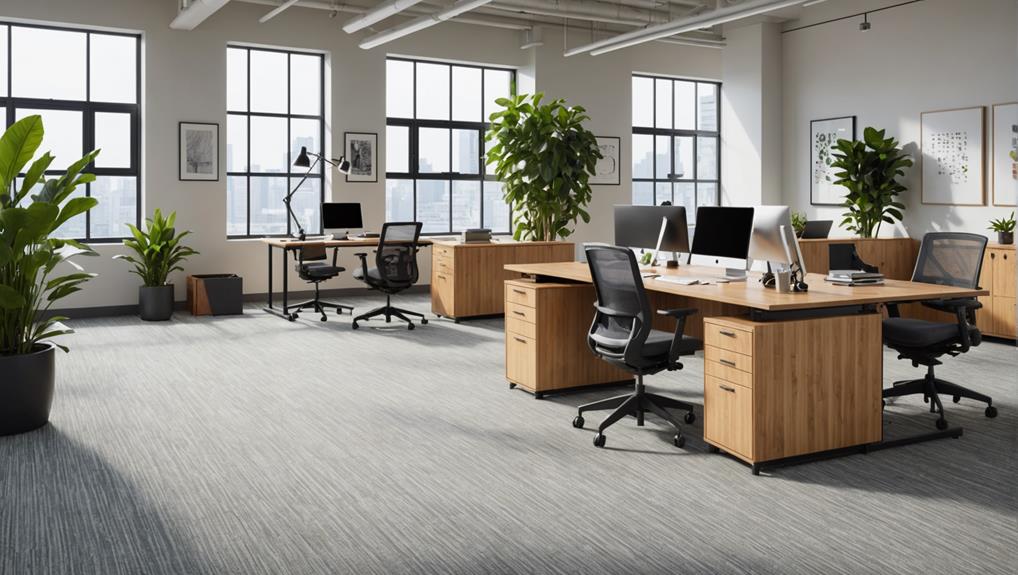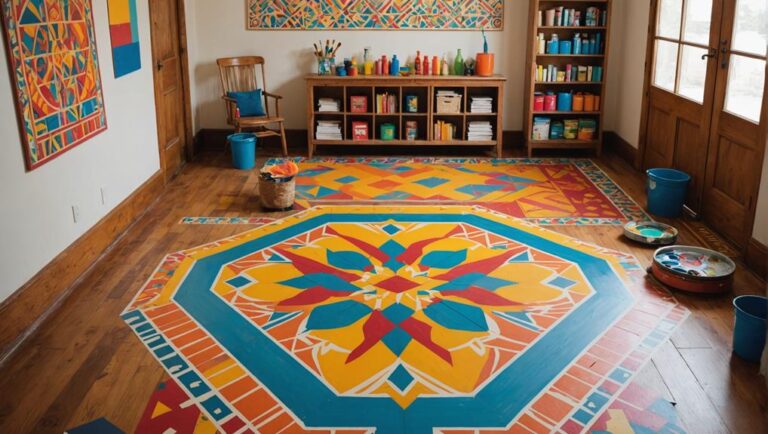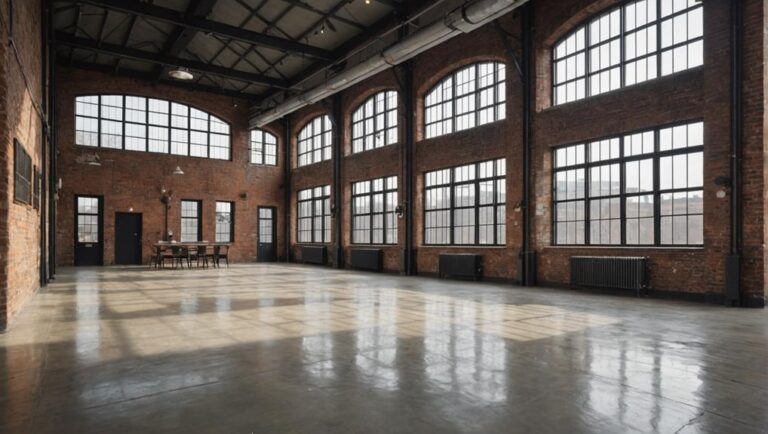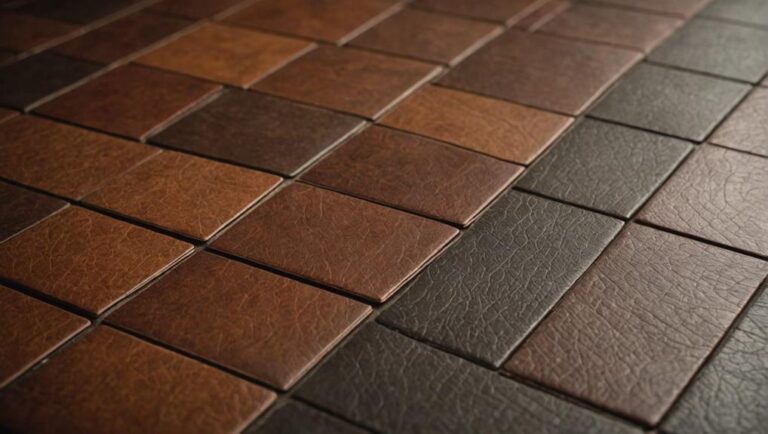When selecting flooring for workspace ergonomics, consider cushioned vinyl or rubber flooring. These options excel in shock absorption, reducing fatigue during prolonged standing. Cushioned vinyl provides a seamless aesthetic and easier maintenance while preventing slips and falls. Carpet tiles also offer design flexibility and acoustic benefits, enhancing comfort and productivity. For hard surfaces, vinyl and laminate can mimic the warmth of wood while ensuring durability. Prioritize safety by choosing slip-resistant options, and balance quality with cost for long-term value. Exploring these options can help you create an environment that boosts comfort and productivity.
Importance of Ergonomic Flooring
When considering the long hours spent on your feet in various environments, the importance of ergonomic flooring becomes clear. This type of flooring isn't just a matter of comfort; it's a vital element in maintaining safety and preventing injuries. An ergonomic assessment of your workspace can reveal how flooring impacts your posture, fatigue levels, and overall well-being.
The right ergonomic flooring can greatly reduce physical strain, especially in settings where employees are required to stand for extended periods. Flooring that offers cushioning and support can minimize the risk of musculoskeletal disorders, which are often exacerbated by hard surfaces. Furthermore, when you evaluate flooring options, keep in mind the durability of the materials. Durable flooring not only withstands heavy foot traffic but also maintains its ergonomic benefits over time, reducing the need for frequent replacements that can disrupt workflow.
Additionally, the safety of your workspace is paramount. Slippery or uneven surfaces can lead to accidents, and selecting flooring designed with safety features can mitigate these risks. For instance, anti-slip surfaces enhance traction, decreasing the likelihood of falls.
Ultimately, investing in high-quality ergonomic flooring is essential for fostering a safe and productive work environment. By prioritizing ergonomic assessments and flooring durability, you're not just improving comfort; you're actively promoting a culture of safety and well-being among your team. This proactive approach not only benefits employees but also enhances overall productivity.
Top Flooring Materials for Comfort
When choosing flooring materials for comfort, cushioning and support are essential factors to take into account. A well-cushioned surface can reduce fatigue and provide better overall support for your feet and joints. Additionally, slip resistance plays an important role in ensuring safety, preventing accidents while maintaining comfort in your space.
Cushioning and Support
Choosing the right flooring can greatly impact your comfort, with some materials providing better cushioning and support than others. When you're on your feet for extended periods, opt for flooring that features cushioned surfaces to reduce fatigue and enhance overall productivity. Proper support systems can help distribute your weight evenly, minimizing strain on your joints and muscles.
Here's a comparison of some top flooring materials that excel in cushioning and support:
| Flooring Material | Cushioning Level |
|---|---|
| Carpet | High |
| Cork | Moderate |
| Foam Tiles | High |
| Vinyl | Moderate |
| Rubber | Very High |
Each of these options offers unique benefits. For instance, carpet provides excellent cushioning but may require more maintenance, while rubber flooring delivers superior shock absorption, ideal for high-traffic environments. By carefully selecting flooring that prioritizes cushioning and support, you can create a workspace that promotes both comfort and safety, allowing you to focus on your tasks without unnecessary discomfort.
Slip Resistance Importance
A significant aspect of flooring selection is slip resistance, which can greatly enhance safety and comfort in any environment. When you're considering flooring materials, it's imperative to guarantee they meet slip resistance standards set forth by regulatory bodies. These standards assess a material's ability to prevent slips in different conditions, such as wet or greasy environments, where accidents are more likely to occur.
Choosing flooring that complies with flooring safety regulations is important for workplaces, especially in areas prone to spills or high foot traffic. For instance, textured surfaces, rubber flooring, and certain types of vinyl can provide excellent traction without sacrificing comfort. By evaluating these materials against established slip resistance metrics, you can greatly reduce the risk of workplace injuries.
Moreover, investing in high-slip-resistant flooring not only safeguards employees but also enhances overall productivity. When people feel secure walking on your floors, they're less distracted by potential hazards. Ultimately, guaranteeing your flooring meets both slip resistance standards and safety regulations is a critical step toward creating a safer, more ergonomic workspace. Remember, safety should always be your top priority when selecting flooring materials.
Benefits of Cushioned Vinyl
Cushioned vinyl offers significant advantages that enhance your comfort while standing or walking. Its soft surface reduces fatigue, allowing you to stay on your feet longer without discomfort. Additionally, this flooring type is easy to maintain, making it a practical choice for busy environments.
Comfort Underfoot
Comfort is a crucial aspect of flooring, especially in spaces where you spend long hours on your feet. Cushioned vinyl flooring offers a unique blend of support and resilience, making it an excellent choice for environments equipped with standing desks. Unlike rigid surfaces, cushioned vinyl provides a softer underfoot experience that reduces pressure on your joints and promotes better posture.
When you're on your feet for extended periods, the comfort of cushioned vinyl can help mitigate discomfort that often leads to fatigue. While anti-fatigue mats serve a similar purpose, they can be cumbersome and may not provide the seamless appearance that cushioned vinyl offers. This type of flooring not only enhances comfort but also contributes to a safer workspace by reducing the risk of slips and falls.
Additionally, cushioned vinyl is easier to clean and maintain, ensuring that your workspace remains hygienic and professional. With its combination of safety, durability, and comfort, cushioned vinyl flooring emerges as a practical option for those who prioritize ergonomic solutions in their work environments. Investing in this flooring can support your well-being while enhancing your productivity throughout the day.
Reduced Fatigue
Choosing cushioned vinyl flooring can greatly reduce fatigue, especially in work environments where standing for long periods is common. This type of flooring offers a softer surface, which absorbs impact and provides better support for your feet and joints. If you use standing desks, the advantages of cushioned vinyl become even more pronounced, as it encourages prolonged comfort and can enhance employee productivity.
Here's a quick comparison of cushioned vinyl benefits versus traditional flooring:
| Feature | Cushioned Vinyl |
|---|---|
| Shock Absorption | High |
| Comfort Level | Excellent |
| Impact on Fatigue | Noticeably Reduced |
| Compatibility with Standing Desks | Ideal |
| Maintenance Requirements | Moderate |
Easy Maintenance
Selecting cushioned vinyl flooring not only enhances comfort and reduces fatigue but also simplifies maintenance considerably. One of the key benefits of this flooring option is its impressive durability. Unlike many other materials, cushioned vinyl is resistant to scratches, stains, and water damage, making it an ideal choice for high-traffic workspaces. You won't have to worry about frequent replacements or extensive repairs, which can save you both time and money.
Cleaning cushioned vinyl is straightforward; a simple sweep or vacuum followed by mopping with a mild detergent is often sufficient. This ease of maintenance guarantees that your workspace remains hygienic and visually appealing, contributing to the overall aesthetic appeal of the environment. Additionally, since cushioned vinyl doesn't harbor allergens or dust mites, it promotes a healthier workspace.
Advantages of Carpet Tiles
Carpet tiles offer several distinct advantages that make them a compelling choice for ergonomic flooring solutions. One of the most notable benefits is their design flexibility. You can easily customize the layout and color schemes to fit your workspace aesthetics and functional needs. This adaptability allows you to create zones that can enhance productivity while also providing a visually appealing environment. With carpet tiles, you're not just limited to one uniform look; you can mix and match patterns to achieve a unique style that resonates with your corporate brand or personal taste.
Another significant advantage is the acoustic benefits they provide. Carpet tiles help absorb sound, reducing noise levels in busy workspaces. This is essential for maintaining a focused and productive atmosphere, especially in open office layouts where distractions can be plentiful. By minimizing sound reverberation, carpet tiles promote better communication among team members, leading to a more harmonious work environment.
Moreover, carpet tiles are designed with safety in mind. Their textured surfaces can help reduce slips and falls, providing an added layer of protection for employees moving around the office. In addition, if a tile gets damaged or stained, you can easily replace just that one tile instead of the entire carpet, ensuring a long-lasting solution that maintains both safety and aesthetics.
Hard Surface Options Explained
Hard surface flooring options, such as hardwood, laminate, vinyl, and tile, offer a range of benefits that can enhance ergonomics in the workplace. Each material presents unique characteristics that contribute to overall safety and comfort.
Hardwood benefits include durability and a natural aesthetic that can create a warm, inviting environment. Its solid surface promotes stability and allows for easy movement of office chairs, reducing the risk of strain when shifting between tasks. Additionally, hardwood can be refinished, extending its lifespan and maintaining its ergonomic qualities over time.
Laminate options, on the other hand, provide an affordable alternative to hardwood while mimicking its appearance. Laminate surfaces are generally easier to clean and maintain, which can contribute to a healthier workspace by reducing allergens. Furthermore, many laminate products are designed with anti-slip features, enhancing safety, especially in high-traffic areas.
Vinyl and tile also deserve mention for their resilience and versatility. Vinyl flooring can absorb sound and provide cushioning underfoot, which can lessen fatigue during long hours of standing or walking. Tile is exceptionally durable and resistant to moisture, making it a suitable choice for various environments such as kitchens or bathrooms.
Ultimately, when considering hard surface flooring options, it is crucial to evaluate each type's ergonomic benefits. Making an informed choice can lead to a workspace that not only looks good but also supports your well-being and productivity.
Tips for Choosing the Right Flooring
When it comes to choosing the right flooring, several key factors can influence your decision and ultimately affect your comfort and productivity. First, consider the ergonomic properties of the flooring material. Soft surfaces, like carpet or rubber, provide cushioning that can reduce fatigue, while harder surfaces, such as tile or hardwood, might lead to discomfort during prolonged standing.
Next, think about design aesthetics. The flooring should complement your workspace's overall look and feel, helping to create an inviting atmosphere. Choose colors and textures that align with your brand identity and enhance the visual appeal of the environment.
Don't forget about budget considerations. Flooring options can vary considerably in price, so it's essential to balance quality with cost. Investing in higher-quality flooring might save you money in the long run through durability and reduced maintenance. Be sure to calculate not just the initial purchase price but also installation and upkeep costs.
Safety is paramount, so consider slip resistance, especially in high-traffic areas or spaces prone to spills. Look for flooring options that provide adequate traction to minimize the risk of accidents.
Frequently Asked Questions
How Does Flooring Affect Overall Employee Productivity Levels?
Flooring greatly impacts overall employee productivity levels. When you choose the right flooring materials, it enhances employee comfort, reducing fatigue and discomfort during long hours. Hard surfaces can lead to strain, while softer, more resilient options provide better support. Comfortably designed flooring can lead to improved focus and efficiency, creating a safer workspace. Ultimately, investing in appropriate flooring not only boosts productivity but also fosters a healthier work environment for everyone involved.
What Is the Lifespan of Ergonomic Flooring Options?
When you think about flooring, durability and comfort often seem at odds. However, ergonomic flooring can provide both. For instance, rubber flooring typically lasts 20-30 years, while vinyl can range from 10-20 years depending on usage. Material comparison reveals that while softer surfaces offer immediate comfort, they may wear faster. Choosing the right option guarantees not just safety but long-term investment in your workspace's functionality and employee well-being.
Can Ergonomic Flooring Reduce Workplace Injuries?
You might wonder if ergonomic flooring can reduce workplace injuries. The answer is yes; these surfaces offer significant ergonomic benefits. By providing cushioning and support, they can help minimize strain on your body during long hours of standing or walking. This injury prevention strategy can lead to fewer musculoskeletal issues and enhances overall comfort. Investing in ergonomic flooring isn't just about aesthetics; it's an essential step towards ensuring a safer, more productive work environment.
Are There Eco-Friendly Options for Ergonomic Flooring?
Sure, because who wouldn't want to tread lightly on the planet while enjoying comfort benefits? Eco-friendly options for ergonomic flooring do exist, featuring sustainable materials like cork, bamboo, and recycled rubber. These materials not only minimize your carbon footprint but also provide cushioning that can help reduce strain on your joints. So, if you're aiming for a safer, more sustainable workspace, these options could be just what you need!
How Do I Maintain Ergonomic Flooring in High-Traffic Areas?
To maintain ergonomic flooring in high-traffic areas, you'll need to focus on the right flooring materials that can withstand wear. Regularly inspect for signs of damage and address them promptly. Establish clear traffic patterns to minimize unnecessary strain on specific areas. Utilizing mats in high-use zones can also help absorb impact and reduce fatigue. Regular cleaning is essential, as dirt can wear down surfaces and compromise safety, so keep your flooring in top shape.




